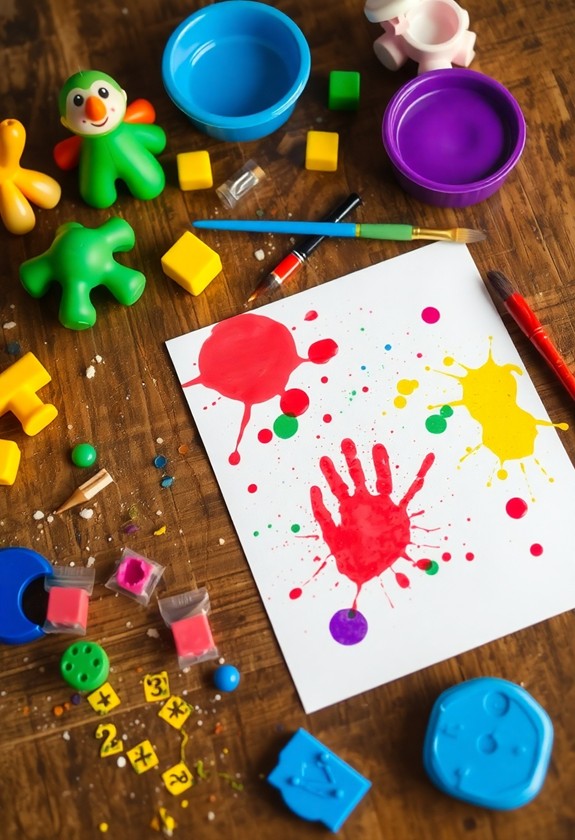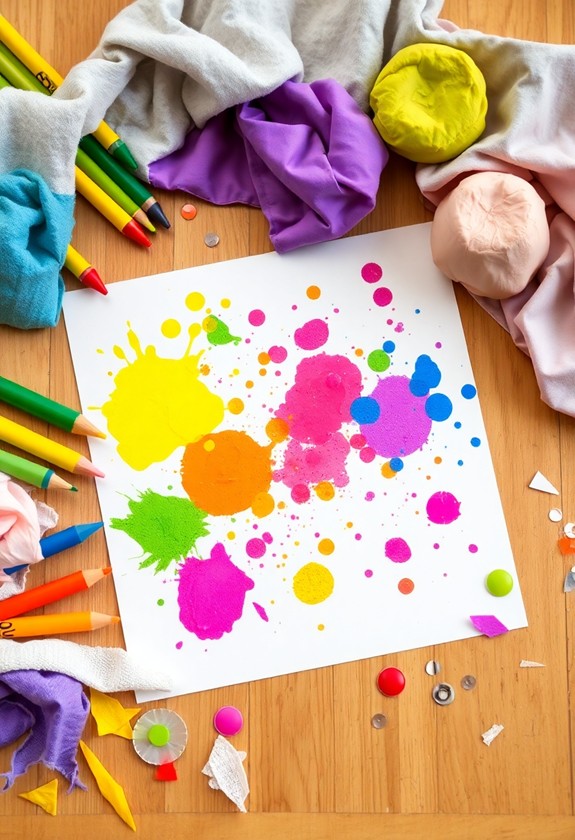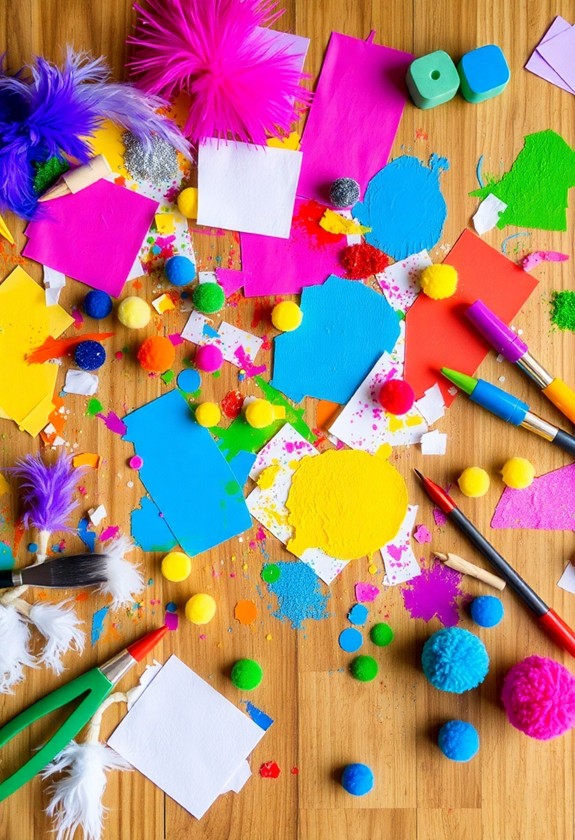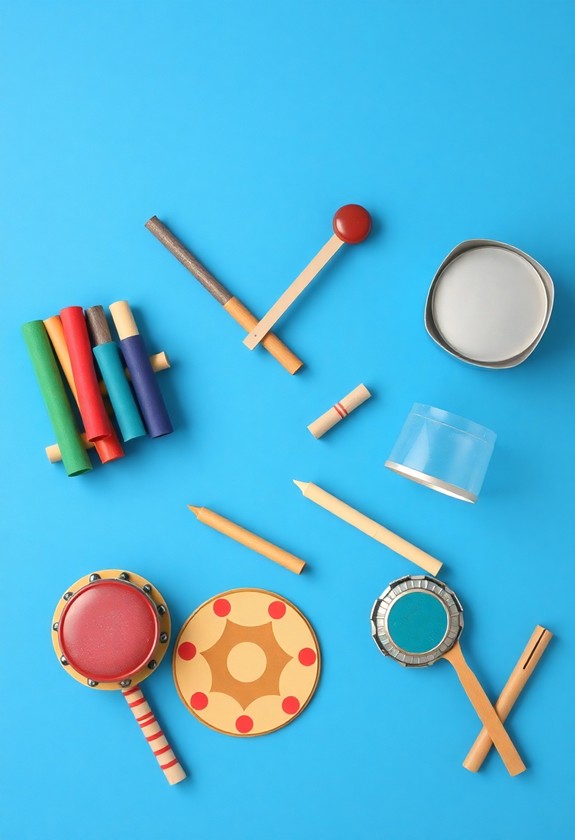Boost your toddler's brain power through sensory art! It's a fun, messy way to stimulate their senses and cognitive growth. Get creative with safe materials like finger paints, play dough, and sponges. Let them squish, splat, and investigate textures as they learn about colors and shapes. Finger painting with pudding? Yum! Sculpting with edible dough? Safe and tasty! These hands-on activities improve fine motor skills, problem-solving, and emotional regulation. Plus, messy play is a blast! From sandboxes to shaving cream art, your little one will be giggling and growing smarter with every squish and splatter. Ready to plunge into a world of colorful, cognitive-boosting fun?
Creative Highlights
- Sensory art stimulates multiple senses, enhancing cognitive growth and fine motor skills in toddlers.
- Non-toxic materials like finger paints and playdough provide safe, hands-on experiences for creative exploration.
- Texture-based activities, such as sandpaper art and bubble wrap printing, encourage tactile learning and pattern recognition.
- Color exploration through painting helps toddlers understand color blending and develops visual perception skills.
- Messy play with materials like edible dough and shaving cream fosters problem-solving and emotional regulation abilities.
Understanding Sensory Art Benefits

Engaging in sensory art activities offers numerous benefits for toddlers' development. It's a fantastic way to stimulate their senses and boost cognitive growth! When your little one squishes paint between their fingers or molds play-dough, they're not just having fun – they're learning! Finger painting with washable, non-toxic paints improves sensory investigation and color recognition, while playdough sculpting boosts fine motor skills and creativity.
Sensory art helps toddlers:
- Develop fine motor skills
- Improve creativity and self-expression
- Enhance focus and concentration
- Build language skills as they describe textures and colors
Plus, it's a great way to bond with your child! You'll love watching their eyes light up as they discover new materials. And don't worry about the mess – that's part of the fun! Sensory art additionally teaches cause and effect, problem-solving, and emotional regulation. It's like a secret weapon for brain development, disguised as playtime! So, get ready to release your inner artist and watch your toddler thrive!
Safe Materials for Toddler Art
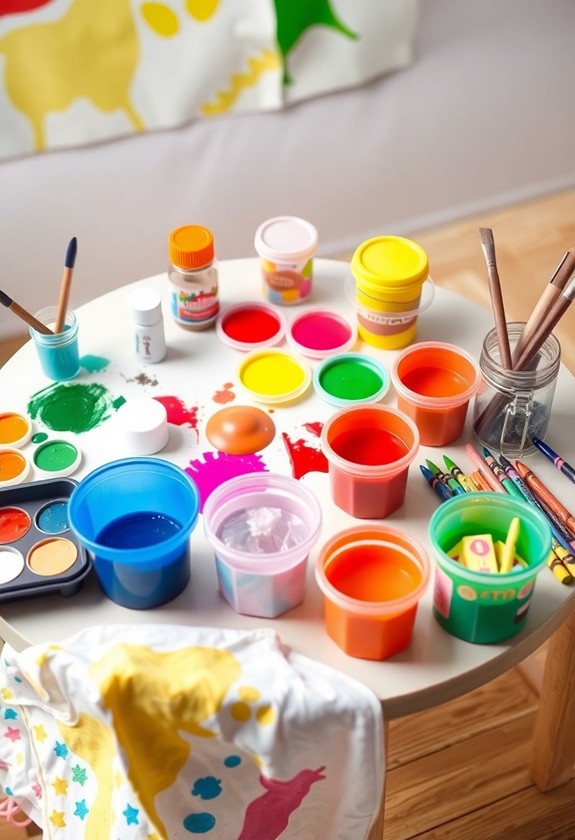
Safety is paramount when selecting art materials for toddlers. You'll want to choose non-toxic, washable options that are perfect for little hands and curious mouths. But don't worry, there's still plenty of room for creativity! Many washable art supplies are designed with age-appropriate features, like triangular shapes for proper grip and crush-proof nibs for durability.
Here are some fantastic, safe materials for your tiny Picasso:
- Finger paints (washable, of course!)
- Chunky, non-toxic crayons
- Play dough (homemade or store-bought)
- Large, soft paintbrushes
- Uncooked pasta for sorting and gluing
These materials are not only safe but furthermore super fun! Your toddler will love squishing, smearing, and investigating different textures. And the best part? You can join in on the messy fun too! Remember, it's all about the process, not the end result. So let those little hands get dirty and watch their imagination soar!
Texture-Based Sensory Art Activities
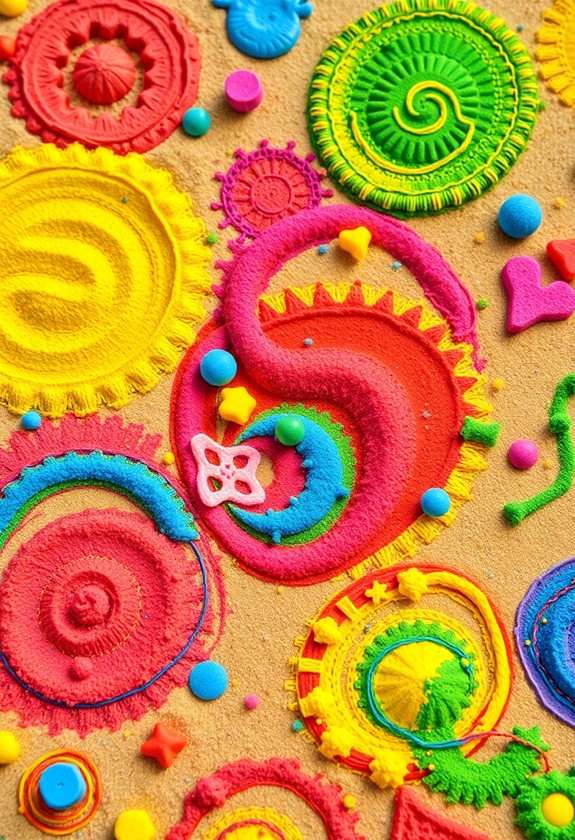
Texture-based sensory art activities are a fantastic way to stimulate your toddler's senses and creativity. These activities can enhance fine motor skills and promote cognitive development through hands-on investigation. Get ready for some messy fun! Try these exciting ideas:
- Finger painting with pudding: Smooth, cool, and tasty!
- Playdough sculpting: Squishy, moldable madness!
- Sandpaper art: Rough and ready for crayons!
- Bubble wrap printing: Pop-tastic patterns!
Create a sensory bin filled with:
- Dried beans
- Uncooked pasta
- Soft pom-poms
- Smooth pebbles
Let your little one examine different textures, sizes, and shapes. They'll love scooping, pouring, and sorting! Don't forget to supervise – no beans up noses, please!
For a tactile treat, make "touch and feel" cards using various materials like:
- Fuzzy felt
- Scratchy burlap
- Silky ribbon
- Bumpy corrugated cardboard
Your toddler will be over the moon with these texture-rific activities!
Color Exploration Through Painting
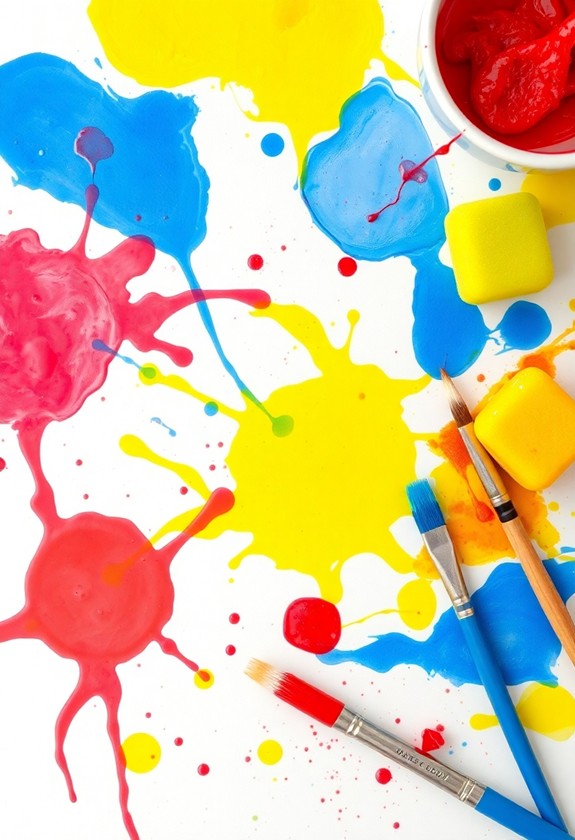
Color exploration through painting opens up a lively world of sensory experiences for toddlers. It's a fantastic way to engage their senses and spark creativity! You'll love watching your little one's eyes light up as they uncover new hues and mixtures. Washable, non-toxic supplies are fundamental for safe and easy cleanup, allowing worry-free creativity. These activities in addition improve fine motor skills and cognitive growth as children experiment with colors and shapes. Get ready for some messy fun!
Exciting color painting activities to try:
- Finger painting with lively, non-toxic paints
- Mixing primary colors to create secondary shades
- Ice cube painting for a cool, melty experience
- Sponge painting with different textures
- Bubble wrap printing for unique patterns
Sculpting With Edible Dough
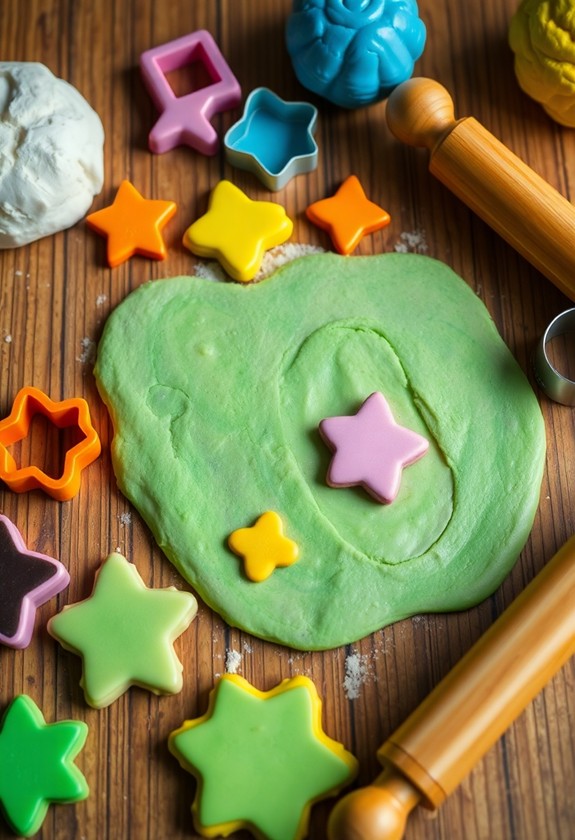
Sculpting with edible dough offers toddlers a delightful, hands-on sensory experience that's safe and engaging. It's a fantastic way to release their creativity as they develop fine motor skills. You can easily whip up a batch of homemade play dough using simple ingredients like flour, salt, and food coloring. Natural colorants derived from fruits, vegetables, and spices can likewise be used to create lively, non-toxic hues. Let your little one knead, roll, and shape the dough to their heart's content!
Encourage them to create:
- Colorful animals
- Silly monsters
- Miniature foods
As they sculpt, they'll investigate textures, colors, and shapes. It's a hands-on learning bonanza! And the best part? If they accidentally taste it, no worries – it's totally safe. So, let their imagination run wild and watch as they mold their masterpieces. Who knows? You might have a future Picasso or "dough-da Vinci" on your hands!
Messy Play and Cognitive Growth
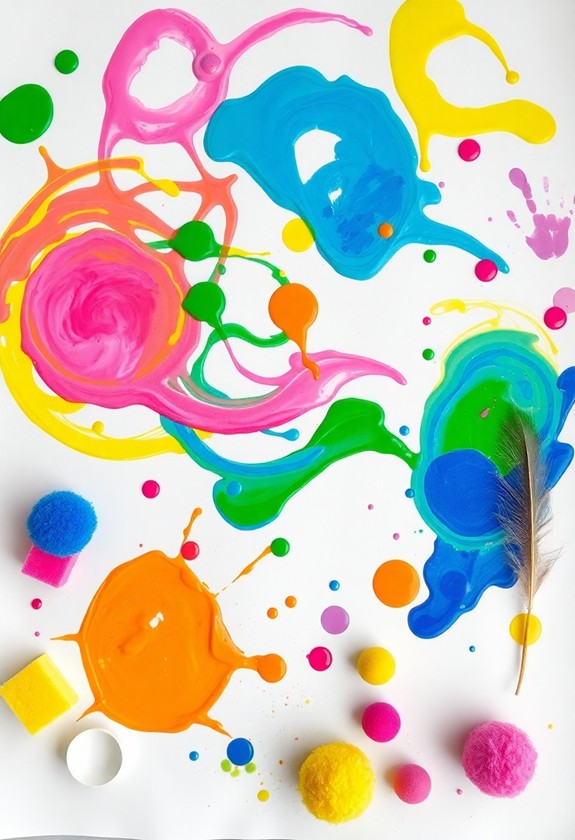
As sculpting with edible dough is a fantastic sensory activity, messy play takes the sensory experience to a whole new level. It's time to get your hands dirty and watch your toddler's cognitive skills soar! Messy play engages multiple senses, promoting brain development in exciting ways. Your little one will love discovering textures, colors, and sensations as they learn about cause and effect. Plus, it's a blast!
Here are some messy play ideas to boost cognitive growth:
- Finger painting with pudding
- Squishy, colorful slime exploration
- Shaving cream art on a mirror
- Water play with cups and funnels
- Sandbox digging and building
Curious Little Questions
How Can I Encourage a Reluctant Toddler to Participate in Sensory Art?
Did you know that 90% of a child's brain development happens before age 5? That's why sensory art is so important! To encourage your reluctant toddler, try these fun tricks:
- Make it messy! Kids love getting dirty.
- Join in! Be their artsy partner-in-crime.
- Offer choices! Let them pick colors or tools.
- Keep it short! Start with 5-minute sessions.
- Praise effort! Celebrate their creations.
What Age Is Appropriate to Start Introducing Sensory Art Activities?
You can start introducing sensory art activities as early as 6 months old. It's never too early to engage your baby's senses! At this age, they're curious and ready to investigate. As they grow, you can gradually introduce more complex activities. By 1-2 years, they'll love finger painting, playdough, and water play. Remember, it's all about fun and inquiry, not perfection. Let your little one get messy and uncover the world through art!
Are There Any Sensory Art Activities Suitable for Children With Allergies?
You don't need to be a Picasso to create allergy-friendly sensory art. Here are some groovy options:
- Use rice or pasta for texture play
- Try finger painting with shaving cream
- Experiment with playdough made from gluten-free flour
- Create nature collages with leaves and twigs
- Make sand art with colored salt
Always check ingredients and supervise closely. And remember, the sky's the limit! With a little creativity, you can craft safe, fun experiences that'll have your little one's senses tingling with joy!
How Often Should Toddlers Engage in Sensory Art for Optimal Benefits?
Hey there, sensory art enthusiasts! You're probably wondering how often your little ones should get their hands messy. Well, here's the scoop: aim for 2-3 times a week! It's the perfect recipe for cognitive growth. But don't stress if you can't stick to a strict schedule. The key is consistency, not perfection. Mix it up with different activities to keep things exciting. Remember, every squish, splat, and smear is helping your toddler's brain bloom. So, let's get creative and have some fun!
Can Sensory Art Help With Language Development in Toddlers?
Sensory art can be a fantastic boost for your toddler's language development. As they squish, splat, and investigate different textures, they're learning new words to describe their experiences. You'll hear them say things like "squishy," "sticky," or "smooth"! Plus, when you chat with them about their creations, you're helping them build vocabulary and communication skills. It's a fun, messy way to expand their language abilities as they're having a blast!

